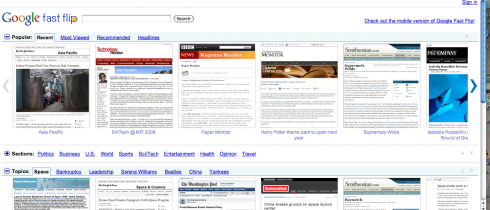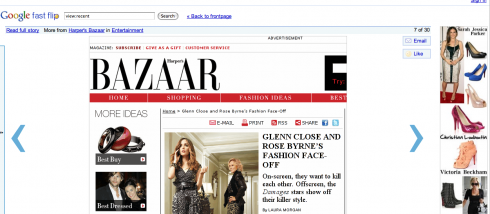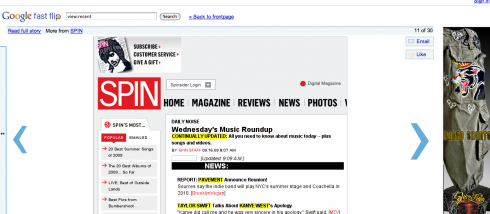Updated Thursday, Sept. 17, 2009, 07:40 EST
TAKEAWAY: With FastFlip, the new Google experimental hub, we have more than just a quick way to access some top notch publications. More importantly, we are seeing what is perhaps one of the most adventurous experiments in the way we will be collecting information, processing it and deciding how much more of it we want and where to get it. Newspapers: watch carefully, some of your future roles may become obvious here. Again, Google innovates in information packaging. PLUS: Pure Design download: garciamedia.com and case studies AND: That London free newspaper, thelondonpaper, closes tomorrow Friday.
thelondonpaper closes Friday

End of a three-year run: thelondonpaper closes tomorrow, making many ponder the question: is this the way of all free newspapers?
Free newspapers also feel the pinch of the economic crisis and the overall dramatic changes that are reshaping our industry.
Tomorrow, News International pulls the plug off its three-year free baby: thelondonpaper. Colorful, people oriented, celebrity obsessed and young, thelondonpaper also had heavy competition from such other titles as Evening Standard, and London Lite.
In addition, Rupert Murdoch has made it known that information costs money and people should pay for it, so to have a freebie out there did not make a lot of sense.
It is all about survival. I have been interviewed three times over breakfast this morning in Italy about “the fate of free newspapers”.
My answer: some will survive. But the formula will have to change. Ten years ago, free newspapers were nirvana for scanners who would get on the train and wanted three paragraph stories about everything that happened while they slept.
Today, mobiles and greater immersion into news websites gives a lot of people that as soon as they jump out of bed. What’s a free newspaper to do?
I still think that we will be looking for substance on paper, speed on screens and mobile phones.
Time for the free newspapers to rethink themselves, like every other newspaper.
Related story:
– UK: News International rebuffs Chinese approach for London Paper
http://www.guardian.co.uk/media/2009/sep/17/london-paper-chinese-approach
Flip for innovation in packaging of information

Here is how the various titles line up next to each other

You stop at whichever title appeals to you, as in Bazaar, then if you wish to go directly to that website, smply click and go—-fast

Or, simply go for a Spin
Google conquers….again
I am in picturesque Genoa, Italy a couple of days, so could not pass on the use of this headline using the famous Vini, Vidi, Vici headline. Except in this case it was Google who came, saw and conquered with its newly introduced Fast Flip news hub experiment.
Indeed, I came to explore the new Google information service and I liked it. It is a good beginning. It signals, I believe, what the future of information consumption may be all about. It may also help to create a better, and much needed, relationship between powerful Google with all its great ideas on the accessing of information, and publishing houses, which have THE information. They need each other.
Google and newspapers/magazines have not had the friendliest of relationships in the past. While journalists admit they could not live without Google—-who could?—-there have been many episodes of distrust, some jealousy, some real charges of Google not paying its dues to those who fabricate the information that the world comes to Google to get. Tons have been written on the subject, and, of course, for all of us who attend and who speak at media conferences, Google is inevitably a hot item on any program these days.
Google seems to have heard the message. It is probably trying to do something about it, too.
On Monday, the company introduced an experimental news hub called Fast Flip—-I love the inclusion of the word Fast here—- that allows users to view news articles from dozens of major publishers and flip through them as quickly as they would the pages of a magazine. Google places the usual ads around the news articles and share resulting revenue with publishers.
Here is the interesting part: “share resulting revenue with publishers”. Now we are talking, I can hear many publishers saying, as they smile.
I confess that I was captivated by the Fast Flip idea, and spent a part of my Wednesday at Munich airport trying it, or, should I say, flipping through it.
FastFlip is fast, indeed
Fast Flip is based on Google execs’ idea that a major problem with news sites is they often are slow to load, and so they turn off many readers—-me included, although this is not so prevalent a problem anymore, not as much as it was in earlier days. Google, the leader in Web search services and advertising, wants to equate the reading experience more to scanning.
I, for one, have been saying for more than a decade that we are all both scanners and devoted readers.
Lately, I believe, the scanners have become better at their game, and they beat the editor to the punch when the eyes land on the page. They search the images, the captions, the headlines and any interesting type set in more than 12 points. Then, and this is a big THEN, complete with a long sigh, they decide if they will read the text—-which may happen later.
How Fast Flip works
Fast Flip, which is available at fastflip.googlelabs.com, first appears as a collection of images of news articles that Google has culled from the sites of its partners. The articles are displayed side by side in various horizontal rails that show them arranged by popularity; sections like politics, business, travel or entertainment; topics like tennis, Iran or the Beatles; and news source. Three dozen publishers, including major news outlets like BBC News, The New York Times, The Washington Post and Newsweek; magazines like Cosmopolitan, The Atlantic, Esquire and Good Housekeeping; and Web-only publications like TechCrunch, Salon.com and Slate.
My review of Fast Flip
Here are some of my observations of this new Google experimental news hub:
1. It is fast, indeed.
2. I wonder who decided what publications to include in this first experimental trial. I can almost predict that already some of the publications not there will be knocking on Google’s door to become part of the experiment.
3. I like the element of serendipity-—sort of walking down the supermarket aisle, if you ask me, and suddenly wanting to eat a delicious tropical fruit that was not on your list at all. For example, my daily online dose would have never taken me to Smithsonian.com and a piece about President Obama’s envisioning of a human mission to Mars. Thank you, Fast Flip. But, this is fun, as I flipped to the next site, it was Fast Company and a story on how to get best concert and sports tickets. Then, down to earth, Spin and the story of how Kanye West called Tanya Swift and apologized sincerely and sweetly for ruining her awards night. Suddenly, I had landed in the tool box of Popular Mechanics (long time no see, I used to read it while having my haircut in the Miami of the 60s when every other magazine was gone!): Alas, a story about the new homesteaders: off the grid and self reliant.
4. It is obvious that Google’s news hub experiment is already aware of the two main behaviors I have mentioned above: scanning and in-depth reading. This hub allows one to do the scanning first, and the immersing second, exactly what we all do, and precisely what I think readers of printed publications do as they scan the publication first, then decide what to read in depth. Google’s news hub is sort of like an entrance to your bathroom: do I take a shower, or do i immerse in the warm waters of the tub for a full bath.
In the case of the Google hub, you can scan the specific article in front of you and either continue flipping to your right to another site, or you can click and go directly to the one publication where you wish to immese.
Follow it, study it, dissect it
All of us in this wonderful media business, especially those with an interest in storytelling and its role in a multiplatform world, do need to stop and analyze the Google Fast Flip experiment. It is significant and I am sure that media historians will some day write about Sept. 14, 2009, the day that Fast Flip took a giant leap in recognizing our appetite for information, our desire to get it faster, and our wish that someone would let us decide whether we scan or immerse.
The concept is not new. Google, as always, knows how to do what publishers have failed to do, to innovate in the area of information packaging.
Google’s Fast Flip has captured it best by recognizing that our informational interests are as varied as our taste for ice cream or cologne. The Fast Flip assumes that “popularly relevant” content—-one of my important new determinants of what makes news—- can live side by side with the more academic or high brow.
Yes, one can go from Mars to the MTV Video Music Awards with just a flip. Not bad. Newspaper editors, take note.
Pure Design download: garciamedia.com case studies
TheMarioBlog posting #369